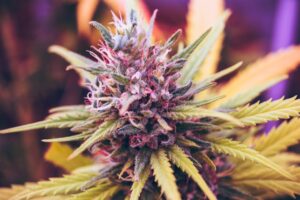A critical part of the plant’s life cycle, the flowering stage of cannabis symbolizes the move from vegetative growth to the budding process. This stage’s buds define the plant’s eventual harvest quality and potency.
During the weeks of flowering, the plant’s needs and appearance change. Week by week developments include pistil growth and bud ripening. By paying close attention to these changes, you can provide the necessary care needed to foster healthy growth and maximize your harvest potential.
Understanding environmental factors, nutrient requirements, and strain-specific requirements is essential to taking care of your cannabis during this crucial time.
Key Takeaways
- Bud development and potency depend on the flowering stage.
- Weekly changes in the plant require specific care and attention.
- Different cannabis strains have unique needs throughout development.
Understanding the Flowering Stage
Cannabis cultivation requires the flowering stage, which marks the transition from vegetative growth to flowering. To maximize the health and output of your plants, you must be aware of the special requirements and qualities of this period.
Transition from the Vegetative (Pre-flowering Stage) to the Flowering Phase
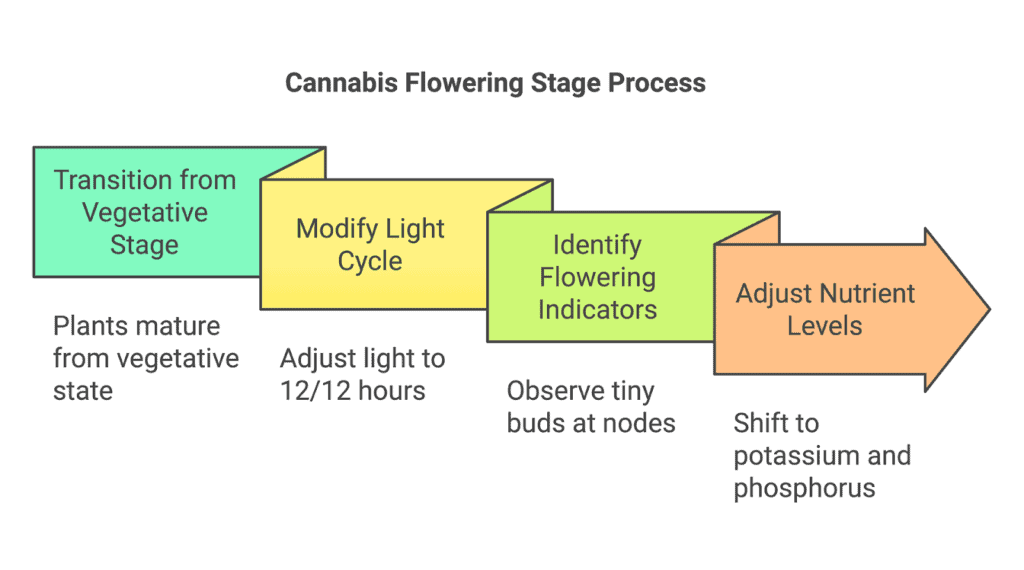
As your plants mature, they eventually start flowering. It usually happens after several weeks in the vegetative stage. Changes in your plant nodes and growth patterns will help you identify this.
You must modify the grow light cycle to trigger the flowering phase. The bulk of growers move to 12 hours of constant light and 12 hours of darkness. This change signals your plants to enter the flowering stage. During the first week, tiny buds at the nodes may indicate flower production.
Maintaining adequate nutrient levels is crucial during this period since your plants may need different nutritional requirements than in the vegetative state. To boost the flowering process, change your nutritional mix; for the best bloom, concentrate on potassium and phosphorus fertilizers.
Significance of Light Cycle in Flowering
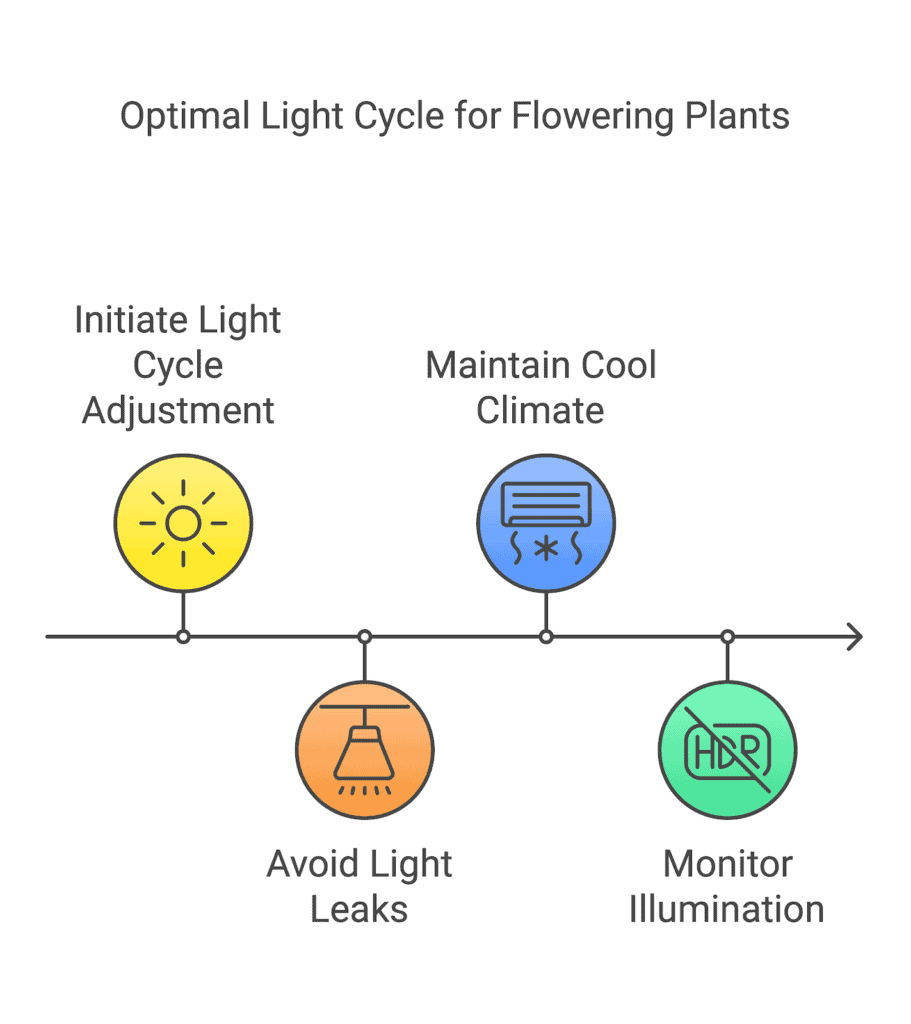
For a flowering stage to be successful, an optimal light cycle is crucial. Changes in the light cycle imitate the plant’s natural environment. This adjustment is necessary to maximize yields and bud growth.
Avoid light leaks during the flowering phase as they can confuse your plants and drive them back into a vegetative state.
Maintain a cool climate throughout the twelve hours of darkness, preferably between 18 and 24°C (65 and 75°F). A balanced temperature and light environment promote healthy buds. Monitoring illumination is critical during this stage.
Week-by-Week Development During the Cannabis Flowering Stage
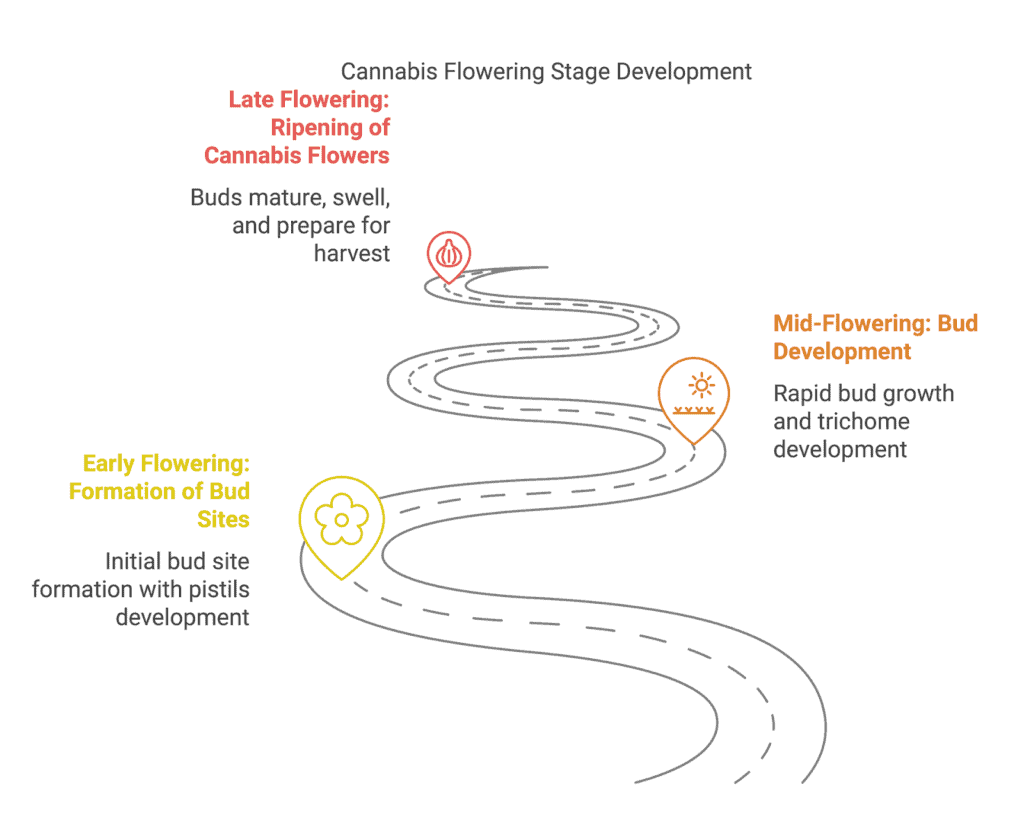
Cannabis plants undergo distinct changes during this stage that affect bud production, growth, and ripening. This weekly evolution must be understood and the signs of flowering monitored to optimize productivity and quality.
Early Flowering: Formation of Bud Sites
Bud site creation begins in week 1 to week 3 of flowering on cannabis plants. This marks the first sign of the transition from the vegetative to the flowering period.
Little white hairs called pistils will start to develop at the nodes where the leaves and stems converge. Flowering is often triggered by a 12/12 light cycle, therefore optimal illumination is necessary.
At this point, the right nutrients are critical. To encourage the formation of bud sites, you might use a fertilizer mix that is richer in potassium and phosphorus. Light leaks can bring plants back to the vegetative stage, thus you must give your plants total darkness throughout dark times if you’re growing cannabis indoors.
Mid-Flowering: Bud Development
Weeks 4 and week 5 are critical for bud growth. Cannabis buds will grow more swiftly and more densely during this period. You may also notice the development of trichomes, which are tiny, glossy structures.
The mid-flowering fertilizer mix should also be adjusted. Increased nitrogen may aid vegetative growth, but don’t overdo it. Focus on a flowering-stage nutrition ratio of 6-10-15 (N-P-K).
Keeping an eye on environmental factors is also advantageous. Set daily highs at 20–24°C (65–75°F) and humidity at 55%. Healthy plants also need adequate ventilation and airflow.
Late Flowering: Ripening of Cannabis Flowers
As weeks 6 to week 9 of the flowering approach, your cannabis flowers will mature. This is when buds will swell significantly and develop their full flavor and potency. Trichomes will become more visible and hazy or amber when the plant is ready.
Now is the time to reduce nutrient application and prepare for harvest. A water flush may remove any residual nutrients from your plants. Although the light cycle remains generally the same, providing plants with 11 hours of light and 13 hours of dark may improve resin synthesis.
Look for signs of disease or pests. Keeping temperature and humidity appropriate helps prevent issues and promote healthy bud growth.
Caring for Cannabis During Flowering
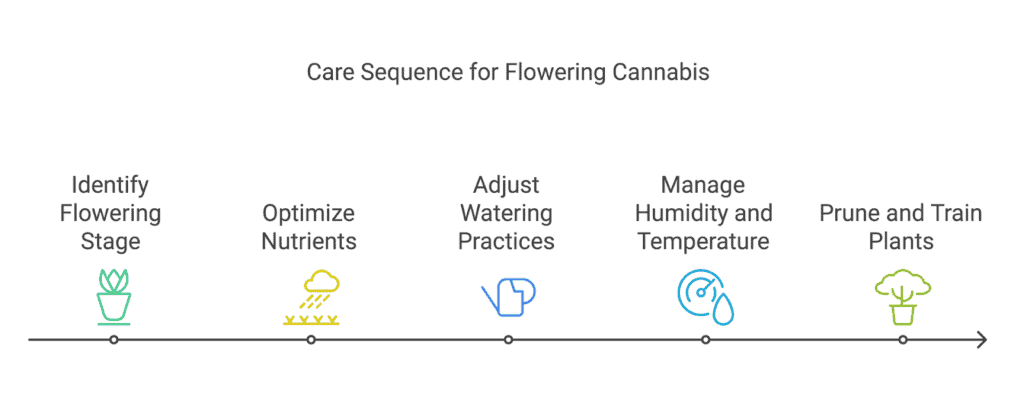
Flowering cannabis requires proper care during the weeks of the flowering stage for healthy growth and maximum yields. Pay attention to environmental factors, nutrition, and pruning to ensure cannabis plant success.
Optimizing Nutrients and Watering Practices
Cannabis needs proper nutrition to bloom. Use a balanced fertilizer with potassium and phosphorus now. These chemicals boost flower growth and potency.
Watering Tips:
- Water plants just when the top inch of soil feels dry.
- Avoid overwatering to avoid root rot.
- Use pH-balanced water to maintain nutrient absorption.
Watch your plants. Make modifications to your feeding routine if your leaves grow yellow or indicate nutrient shortages. Don’t remove fan leaves until needed.
Managing Humidity and Temperature
Temperature and humidity also affect flowering. The optimal humidity is 35–55%. High amounts can cause mold, while low levels stress plants.
Temperature Guidelines:
- Aim for 70–80°F during the day.
- Nighttime temperatures should be lower.
Fans circulate air. This reduces humidity and strengthens stems. Regularly check your plants to ensure they’re happy in their environment.
Pruning and Training Techniques
Flowering requires regular pruning to increase light and ventilation. Remove lower branches and unlit fan leaves. This concentrates energy on the main buds.
Training methods:
- Use Low Stress Training (LST) to gently bend branches.
- Consider using nets or trellises to support heavy branches.
Both promote stronger growth and higher yields. Avoid stressing your plants, which can reduce bud production. Regular pruning helps maintain health and structure during this crucial phase.
Bud Harvesting and Post-Production
Harvesting cannabis at the right time is crucial for achieving optimal potency and flavor. After the flowering stage, you’ll analyze trichomes and other factors to determine the perfect moment for your plants. Following the harvest, proper post-production techniques will enhance the quality of your cannabis.
Determining Harvest Time
To know when to start harvesting, observe your plant’s trichomes. You want to look for a mix of cloudy and amber trichomes. A good target is about 10%-20% amber to ensure peak potency.
Additionally, monitor the pistils (the hair-like structures on the buds). When around 70-90% of the pistils have darkened, your plant is likely ready to be harvested. The timing can also depend on the strain and desired effects. Take careful notes during this process to refine your skills for future growth.
Trimming, Drying, and Curing Process
After harvesting, the next steps are trimming, drying, and curing your cannabis. Start by trimming away excess leaves, this helps focus on the buds and improves drying. Use sharp scissors for clean cuts.
Next, hang the trimmed buds upside down in a cool, dark place with low humidity. Aim for a temperature of 60-70°F (15-21°C). Allow the buds to dry for about 7-14 days until stems snap easily.
Once dried, curing is essential for enhancing flavor and smoothness. Place the buds in glass jars, filling them about 70% full. Keep the jars in a cool place, opening them daily to allow fresh air in. Continue this process for about 2-4 weeks for optimal results.
Considerations for Different Cannabis Strains
When growing cannabis, knowing the type of strain you are working with is essential. Different strains have specific needs and characteristics. This will affect how you manage their flowering stages and overall growth.
Autoflowering vs Photoperiod Strains
Autoflowering cannabis strains switch from the vegetative growth stage to the flowering stage automatically, usually around 2 to 4 weeks after germination. This feature allows you to cultivate them in smaller grow spaces with less concern for light cycles. They typically flower in about 8 to 10 weeks.
On the other hand, photoperiod strains require specific light conditions to trigger flowering. You need to provide 12 hours of light and 12 hours of dark to induce this phase. They often take longer to flower, ranging from 8 to 16 weeks, depending on the strain. Understanding these differences allows you to plan your growing space and schedule effectively.
Indica, Sativa, and Hybrid Varieties
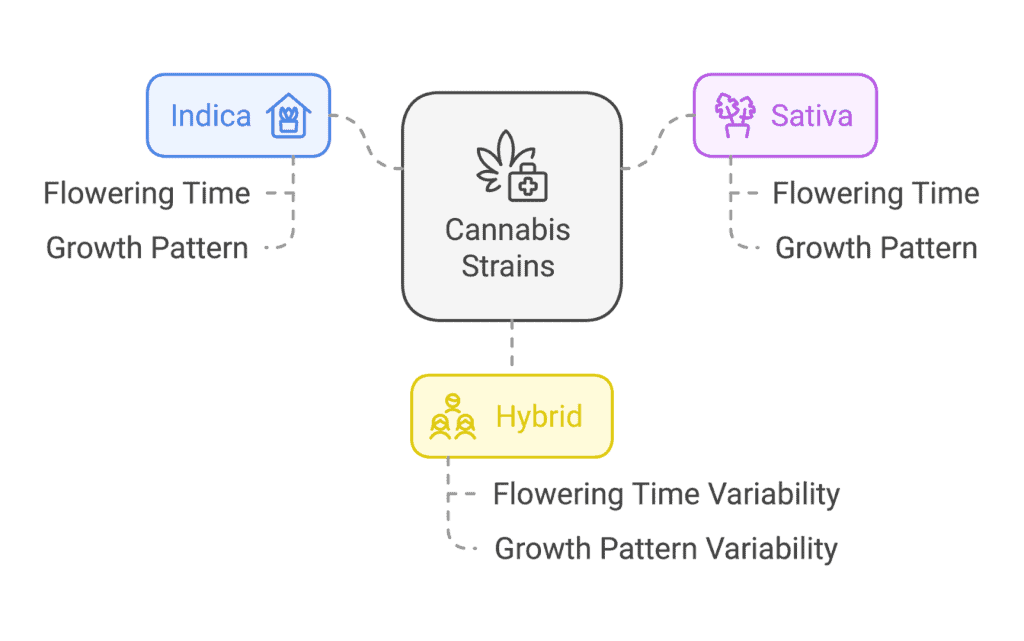
Indica strains generally flower faster than sativa strains, usually requiring 6 to 10 weeks. They often have compact growth patterns, making them suitable for smaller indoor growing setups. You can manage their flowering with less light and monitoring.
Sativa strains, in contrast, tend to take longer, requiring up to 16 weeks to flower. They grow taller and may need more space vertically in your grow area. Hybrid varieties combine traits from both, meaning their flowering time and growth characteristics can vary widely.
By understanding these types, growers can make informed choices about cannabis seeds and optimize their cultivation approach.
Bottom Line
Mastering the flowering stage is essential for any grower aiming to produce high-quality cannabis with optimal potency and flavor. By closely monitoring week-by-week developments and addressing the unique needs of your plants, you can prevent issues like stunted growth or plants that stop growing altogether.
From the seedling stage to the pre-flowering stage and finally the harvest, understanding environmental factors and strain-specific requirements allows every grower to maximize their harvest potential. With proper care and attention, the flowering stage becomes a rewarding milestone in a grower’s cultivation journey.
Frequently Asked Questions on Flowering Cannabis Plants
What is the average cannabis flowering time?
Cannabis flowering takes 6–12 weeks. Indica strains flower in 6–8 weeks, while sativa strains take 8–12 weeks. Time may depend on strain and growth conditions.
Which indicators lead to the start of the flowering cycle in cannabis plants grown outdoors?
Outdoor plants begin flowering when daylight changes. As days shorten, plants generate pre-flowers. These pre-flowers help identify male and female cannabis plants.
What visual changes might be expected during cannabis flowering?
The first few weeks of blossoming will see buds form. Buds will sprout trichomes and expand. In weeks four to six, buds thicken and grow.
When should fan leaves be removed during the flowering stage of cannabis?
Fan leaves are best removed late in flowering. Pay attention to the leaves that impede the buds’ access to light. Retaining appropriate leaves is critical for the plant’s health and vitality, so don’t remove too many.
How do you know when cannabis buds are ready to harvest after flowering?
Keep an eye on the color of the trichomes to detect when they are ready to be harvested. They should go clear, then milky white, and eventually amber. This shift signals peak bud potency and lets you know it’s time to start harvesting.
What can you expect in the fifth week of cannabis flowering?
By week 5, buds should be fully formed and stacking. The plants should smell pungent and have more trichomes. Nutritional adjustments are needed now to boost bud growth.








